HI6005 - Management: Corporate Culture and Organizational Success
VerifiedAdded on 2022/11/16
|11
|4170
|274
Report
AI Summary
This report delves into the critical role of corporate culture as a determinant of organizational success, particularly within a global environment. It emphasizes how a positive corporate culture enhances employee productivity, fosters healthy competition, and sets clear guidelines, ultimately influencing a company's brand image and creating a sense of unity among employees. The report explores the dimensions used to describe organizational culture, such as being detail-oriented, innovative, and aggressive. Real-world examples, like Google's culture, are used to illustrate how these dimensions influence the company's operations and success in the competitive market. The report also highlights the importance of human resource development programs and a hands-on approach in maintaining a strong corporate culture. It also discusses how different dimensions of organizational culture are evaluated to ensure that companies have a clear understanding of the factors that contribute to their success in the market.
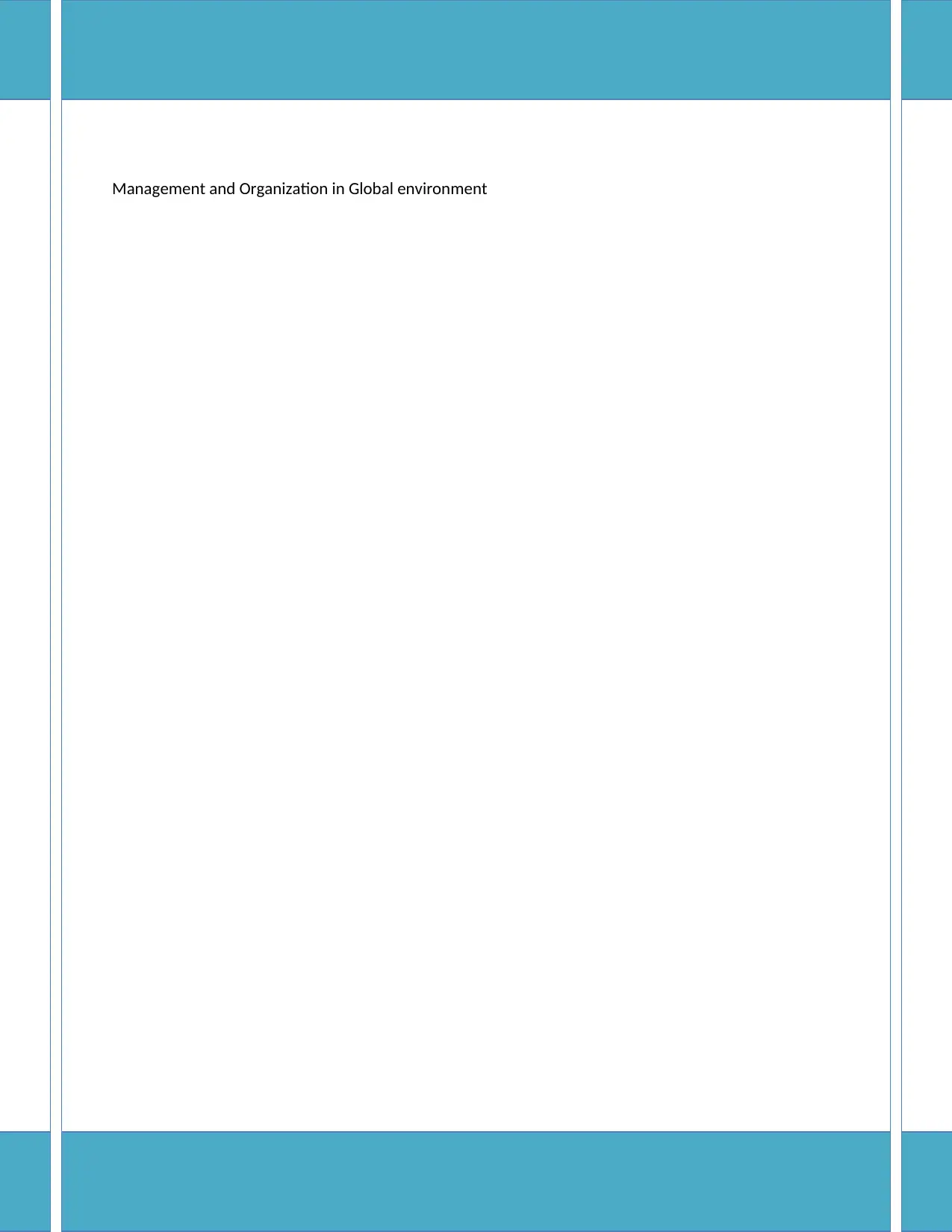
Management and Organization in Global environment
Paraphrase This Document
Need a fresh take? Get an instant paraphrase of this document with our AI Paraphraser
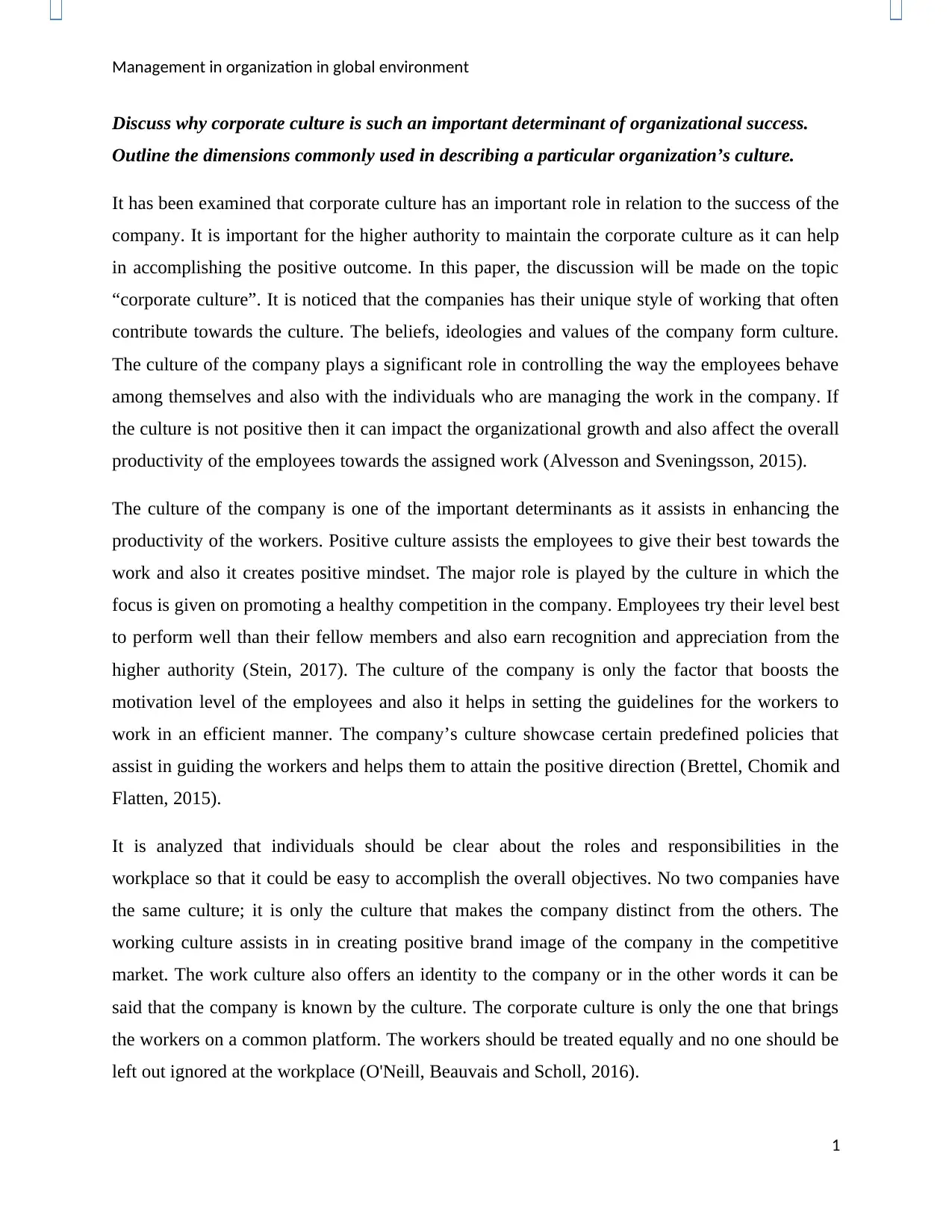
Management in organization in global environment
Discuss why corporate culture is such an important determinant of organizational success.
Outline the dimensions commonly used in describing a particular organization’s culture.
It has been examined that corporate culture has an important role in relation to the success of the
company. It is important for the higher authority to maintain the corporate culture as it can help
in accomplishing the positive outcome. In this paper, the discussion will be made on the topic
“corporate culture”. It is noticed that the companies has their unique style of working that often
contribute towards the culture. The beliefs, ideologies and values of the company form culture.
The culture of the company plays a significant role in controlling the way the employees behave
among themselves and also with the individuals who are managing the work in the company. If
the culture is not positive then it can impact the organizational growth and also affect the overall
productivity of the employees towards the assigned work (Alvesson and Sveningsson, 2015).
The culture of the company is one of the important determinants as it assists in enhancing the
productivity of the workers. Positive culture assists the employees to give their best towards the
work and also it creates positive mindset. The major role is played by the culture in which the
focus is given on promoting a healthy competition in the company. Employees try their level best
to perform well than their fellow members and also earn recognition and appreciation from the
higher authority (Stein, 2017). The culture of the company is only the factor that boosts the
motivation level of the employees and also it helps in setting the guidelines for the workers to
work in an efficient manner. The company’s culture showcase certain predefined policies that
assist in guiding the workers and helps them to attain the positive direction (Brettel, Chomik and
Flatten, 2015).
It is analyzed that individuals should be clear about the roles and responsibilities in the
workplace so that it could be easy to accomplish the overall objectives. No two companies have
the same culture; it is only the culture that makes the company distinct from the others. The
working culture assists in in creating positive brand image of the company in the competitive
market. The work culture also offers an identity to the company or in the other words it can be
said that the company is known by the culture. The corporate culture is only the one that brings
the workers on a common platform. The workers should be treated equally and no one should be
left out ignored at the workplace (O'Neill, Beauvais and Scholl, 2016).
1
Discuss why corporate culture is such an important determinant of organizational success.
Outline the dimensions commonly used in describing a particular organization’s culture.
It has been examined that corporate culture has an important role in relation to the success of the
company. It is important for the higher authority to maintain the corporate culture as it can help
in accomplishing the positive outcome. In this paper, the discussion will be made on the topic
“corporate culture”. It is noticed that the companies has their unique style of working that often
contribute towards the culture. The beliefs, ideologies and values of the company form culture.
The culture of the company plays a significant role in controlling the way the employees behave
among themselves and also with the individuals who are managing the work in the company. If
the culture is not positive then it can impact the organizational growth and also affect the overall
productivity of the employees towards the assigned work (Alvesson and Sveningsson, 2015).
The culture of the company is one of the important determinants as it assists in enhancing the
productivity of the workers. Positive culture assists the employees to give their best towards the
work and also it creates positive mindset. The major role is played by the culture in which the
focus is given on promoting a healthy competition in the company. Employees try their level best
to perform well than their fellow members and also earn recognition and appreciation from the
higher authority (Stein, 2017). The culture of the company is only the factor that boosts the
motivation level of the employees and also it helps in setting the guidelines for the workers to
work in an efficient manner. The company’s culture showcase certain predefined policies that
assist in guiding the workers and helps them to attain the positive direction (Brettel, Chomik and
Flatten, 2015).
It is analyzed that individuals should be clear about the roles and responsibilities in the
workplace so that it could be easy to accomplish the overall objectives. No two companies have
the same culture; it is only the culture that makes the company distinct from the others. The
working culture assists in in creating positive brand image of the company in the competitive
market. The work culture also offers an identity to the company or in the other words it can be
said that the company is known by the culture. The corporate culture is only the one that brings
the workers on a common platform. The workers should be treated equally and no one should be
left out ignored at the workplace (O'Neill, Beauvais and Scholl, 2016).
1
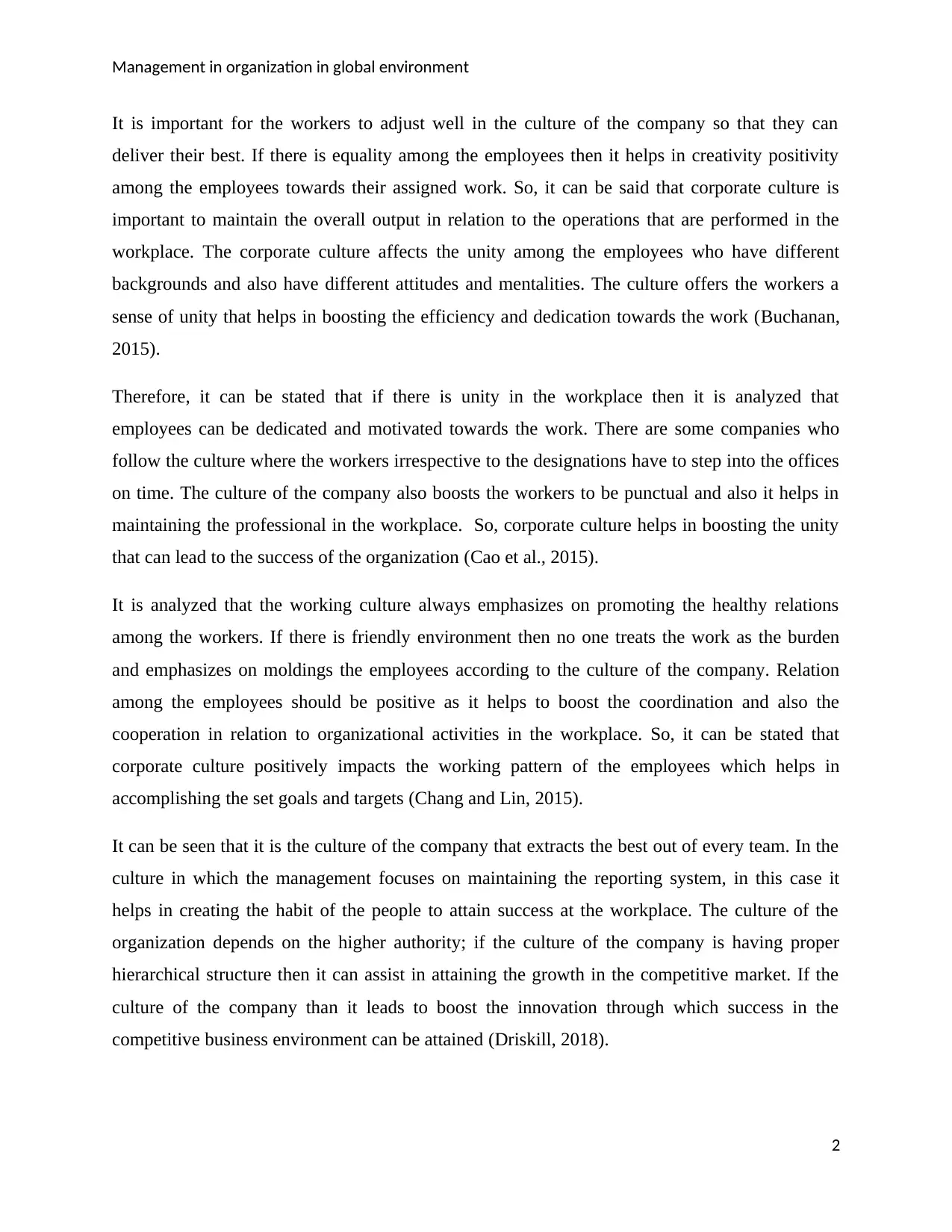
Management in organization in global environment
It is important for the workers to adjust well in the culture of the company so that they can
deliver their best. If there is equality among the employees then it helps in creativity positivity
among the employees towards their assigned work. So, it can be said that corporate culture is
important to maintain the overall output in relation to the operations that are performed in the
workplace. The corporate culture affects the unity among the employees who have different
backgrounds and also have different attitudes and mentalities. The culture offers the workers a
sense of unity that helps in boosting the efficiency and dedication towards the work (Buchanan,
2015).
Therefore, it can be stated that if there is unity in the workplace then it is analyzed that
employees can be dedicated and motivated towards the work. There are some companies who
follow the culture where the workers irrespective to the designations have to step into the offices
on time. The culture of the company also boosts the workers to be punctual and also it helps in
maintaining the professional in the workplace. So, corporate culture helps in boosting the unity
that can lead to the success of the organization (Cao et al., 2015).
It is analyzed that the working culture always emphasizes on promoting the healthy relations
among the workers. If there is friendly environment then no one treats the work as the burden
and emphasizes on moldings the employees according to the culture of the company. Relation
among the employees should be positive as it helps to boost the coordination and also the
cooperation in relation to organizational activities in the workplace. So, it can be stated that
corporate culture positively impacts the working pattern of the employees which helps in
accomplishing the set goals and targets (Chang and Lin, 2015).
It can be seen that it is the culture of the company that extracts the best out of every team. In the
culture in which the management focuses on maintaining the reporting system, in this case it
helps in creating the habit of the people to attain success at the workplace. The culture of the
organization depends on the higher authority; if the culture of the company is having proper
hierarchical structure then it can assist in attaining the growth in the competitive market. If the
culture of the company than it leads to boost the innovation through which success in the
competitive business environment can be attained (Driskill, 2018).
2
It is important for the workers to adjust well in the culture of the company so that they can
deliver their best. If there is equality among the employees then it helps in creativity positivity
among the employees towards their assigned work. So, it can be said that corporate culture is
important to maintain the overall output in relation to the operations that are performed in the
workplace. The corporate culture affects the unity among the employees who have different
backgrounds and also have different attitudes and mentalities. The culture offers the workers a
sense of unity that helps in boosting the efficiency and dedication towards the work (Buchanan,
2015).
Therefore, it can be stated that if there is unity in the workplace then it is analyzed that
employees can be dedicated and motivated towards the work. There are some companies who
follow the culture where the workers irrespective to the designations have to step into the offices
on time. The culture of the company also boosts the workers to be punctual and also it helps in
maintaining the professional in the workplace. So, corporate culture helps in boosting the unity
that can lead to the success of the organization (Cao et al., 2015).
It is analyzed that the working culture always emphasizes on promoting the healthy relations
among the workers. If there is friendly environment then no one treats the work as the burden
and emphasizes on moldings the employees according to the culture of the company. Relation
among the employees should be positive as it helps to boost the coordination and also the
cooperation in relation to organizational activities in the workplace. So, it can be stated that
corporate culture positively impacts the working pattern of the employees which helps in
accomplishing the set goals and targets (Chang and Lin, 2015).
It can be seen that it is the culture of the company that extracts the best out of every team. In the
culture in which the management focuses on maintaining the reporting system, in this case it
helps in creating the habit of the people to attain success at the workplace. The culture of the
organization depends on the higher authority; if the culture of the company is having proper
hierarchical structure then it can assist in attaining the growth in the competitive market. If the
culture of the company than it leads to boost the innovation through which success in the
competitive business environment can be attained (Driskill, 2018).
2
⊘ This is a preview!⊘
Do you want full access?
Subscribe today to unlock all pages.

Trusted by 1+ million students worldwide
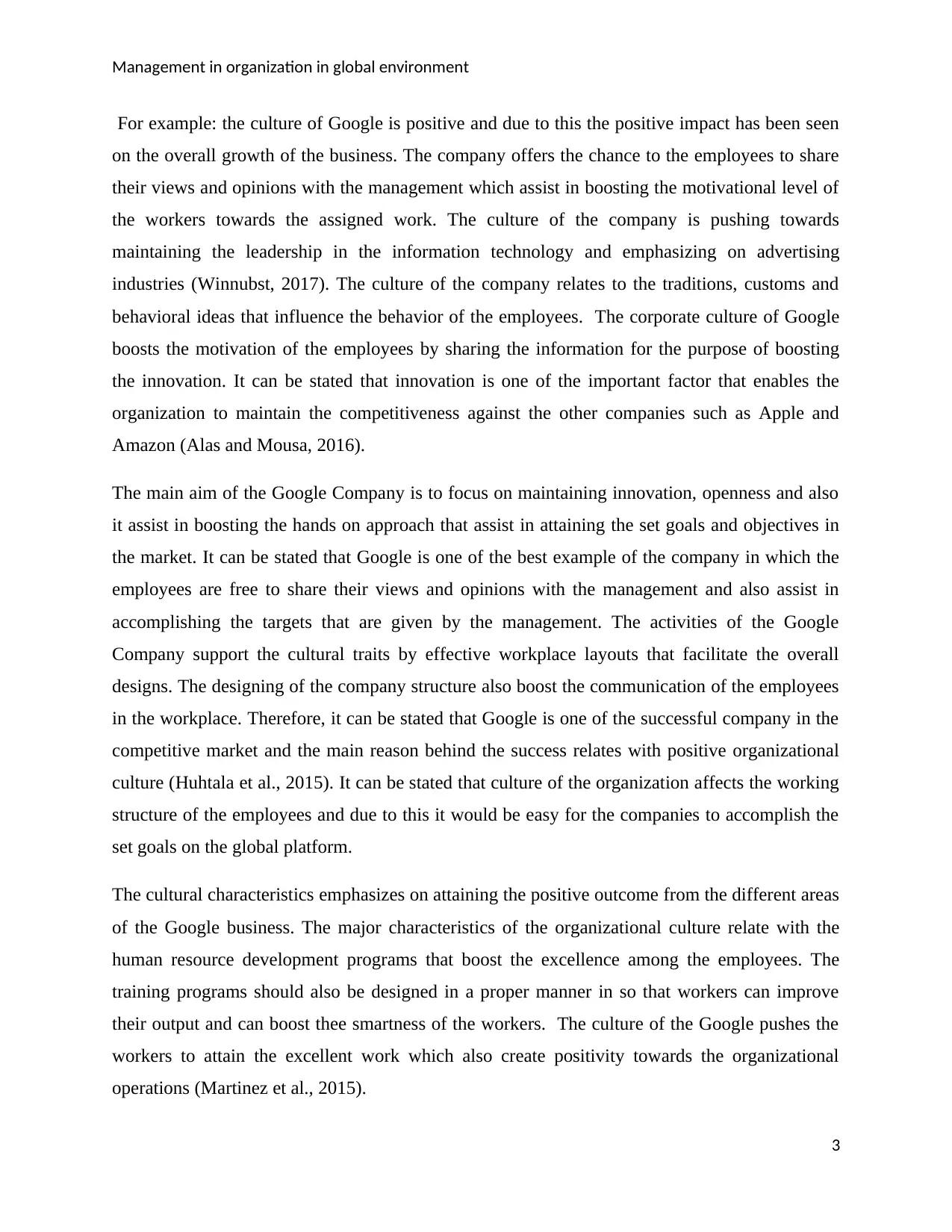
Management in organization in global environment
For example: the culture of Google is positive and due to this the positive impact has been seen
on the overall growth of the business. The company offers the chance to the employees to share
their views and opinions with the management which assist in boosting the motivational level of
the workers towards the assigned work. The culture of the company is pushing towards
maintaining the leadership in the information technology and emphasizing on advertising
industries (Winnubst, 2017). The culture of the company relates to the traditions, customs and
behavioral ideas that influence the behavior of the employees. The corporate culture of Google
boosts the motivation of the employees by sharing the information for the purpose of boosting
the innovation. It can be stated that innovation is one of the important factor that enables the
organization to maintain the competitiveness against the other companies such as Apple and
Amazon (Alas and Mousa, 2016).
The main aim of the Google Company is to focus on maintaining innovation, openness and also
it assist in boosting the hands on approach that assist in attaining the set goals and objectives in
the market. It can be stated that Google is one of the best example of the company in which the
employees are free to share their views and opinions with the management and also assist in
accomplishing the targets that are given by the management. The activities of the Google
Company support the cultural traits by effective workplace layouts that facilitate the overall
designs. The designing of the company structure also boost the communication of the employees
in the workplace. Therefore, it can be stated that Google is one of the successful company in the
competitive market and the main reason behind the success relates with positive organizational
culture (Huhtala et al., 2015). It can be stated that culture of the organization affects the working
structure of the employees and due to this it would be easy for the companies to accomplish the
set goals on the global platform.
The cultural characteristics emphasizes on attaining the positive outcome from the different areas
of the Google business. The major characteristics of the organizational culture relate with the
human resource development programs that boost the excellence among the employees. The
training programs should also be designed in a proper manner in so that workers can improve
their output and can boost thee smartness of the workers. The culture of the Google pushes the
workers to attain the excellent work which also create positivity towards the organizational
operations (Martinez et al., 2015).
3
For example: the culture of Google is positive and due to this the positive impact has been seen
on the overall growth of the business. The company offers the chance to the employees to share
their views and opinions with the management which assist in boosting the motivational level of
the workers towards the assigned work. The culture of the company is pushing towards
maintaining the leadership in the information technology and emphasizing on advertising
industries (Winnubst, 2017). The culture of the company relates to the traditions, customs and
behavioral ideas that influence the behavior of the employees. The corporate culture of Google
boosts the motivation of the employees by sharing the information for the purpose of boosting
the innovation. It can be stated that innovation is one of the important factor that enables the
organization to maintain the competitiveness against the other companies such as Apple and
Amazon (Alas and Mousa, 2016).
The main aim of the Google Company is to focus on maintaining innovation, openness and also
it assist in boosting the hands on approach that assist in attaining the set goals and objectives in
the market. It can be stated that Google is one of the best example of the company in which the
employees are free to share their views and opinions with the management and also assist in
accomplishing the targets that are given by the management. The activities of the Google
Company support the cultural traits by effective workplace layouts that facilitate the overall
designs. The designing of the company structure also boost the communication of the employees
in the workplace. Therefore, it can be stated that Google is one of the successful company in the
competitive market and the main reason behind the success relates with positive organizational
culture (Huhtala et al., 2015). It can be stated that culture of the organization affects the working
structure of the employees and due to this it would be easy for the companies to accomplish the
set goals on the global platform.
The cultural characteristics emphasizes on attaining the positive outcome from the different areas
of the Google business. The major characteristics of the organizational culture relate with the
human resource development programs that boost the excellence among the employees. The
training programs should also be designed in a proper manner in so that workers can improve
their output and can boost thee smartness of the workers. The culture of the Google pushes the
workers to attain the excellent work which also create positivity towards the organizational
operations (Martinez et al., 2015).
3
Paraphrase This Document
Need a fresh take? Get an instant paraphrase of this document with our AI Paraphraser
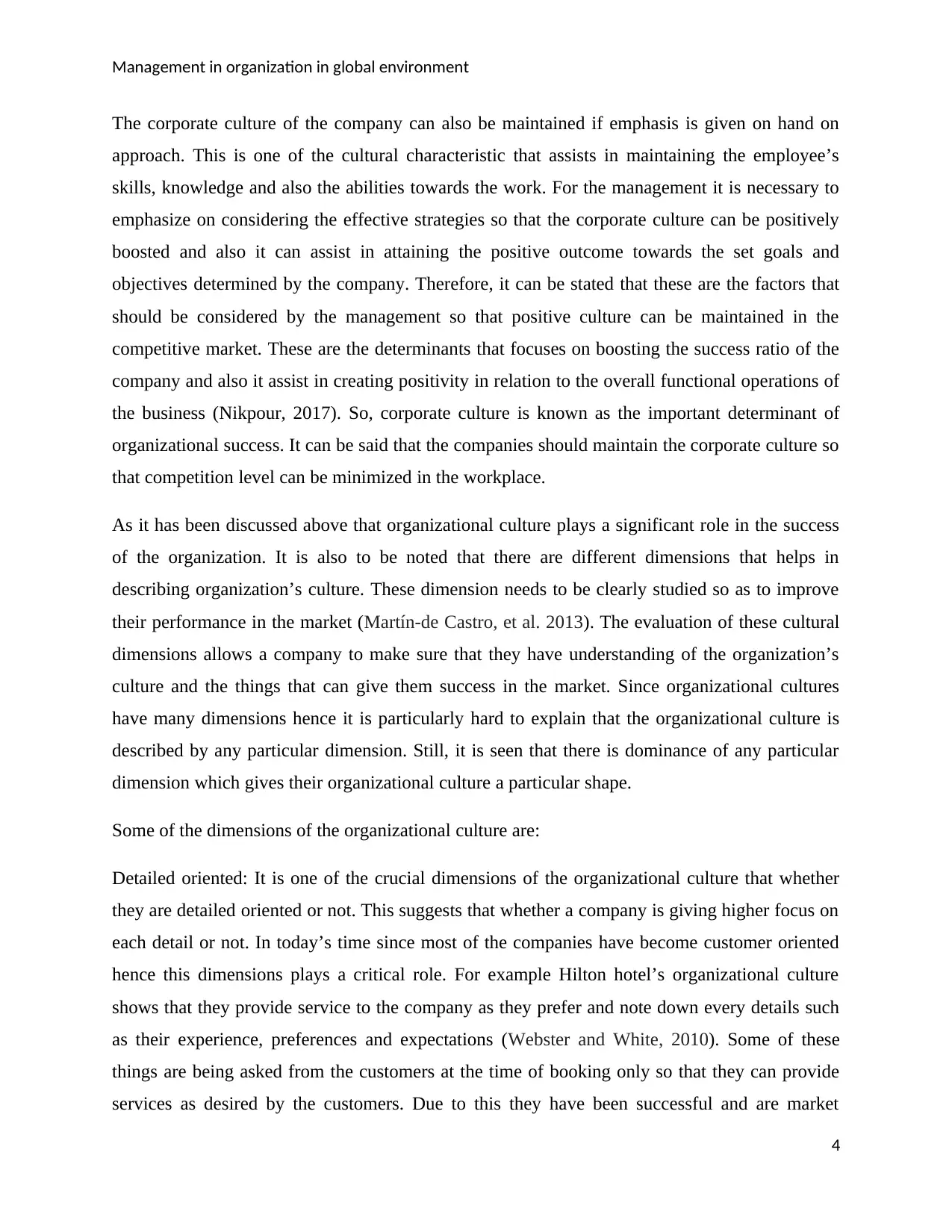
Management in organization in global environment
The corporate culture of the company can also be maintained if emphasis is given on hand on
approach. This is one of the cultural characteristic that assists in maintaining the employee’s
skills, knowledge and also the abilities towards the work. For the management it is necessary to
emphasize on considering the effective strategies so that the corporate culture can be positively
boosted and also it can assist in attaining the positive outcome towards the set goals and
objectives determined by the company. Therefore, it can be stated that these are the factors that
should be considered by the management so that positive culture can be maintained in the
competitive market. These are the determinants that focuses on boosting the success ratio of the
company and also it assist in creating positivity in relation to the overall functional operations of
the business (Nikpour, 2017). So, corporate culture is known as the important determinant of
organizational success. It can be said that the companies should maintain the corporate culture so
that competition level can be minimized in the workplace.
As it has been discussed above that organizational culture plays a significant role in the success
of the organization. It is also to be noted that there are different dimensions that helps in
describing organization’s culture. These dimension needs to be clearly studied so as to improve
their performance in the market (Martín-de Castro, et al. 2013). The evaluation of these cultural
dimensions allows a company to make sure that they have understanding of the organization’s
culture and the things that can give them success in the market. Since organizational cultures
have many dimensions hence it is particularly hard to explain that the organizational culture is
described by any particular dimension. Still, it is seen that there is dominance of any particular
dimension which gives their organizational culture a particular shape.
Some of the dimensions of the organizational culture are:
Detailed oriented: It is one of the crucial dimensions of the organizational culture that whether
they are detailed oriented or not. This suggests that whether a company is giving higher focus on
each detail or not. In today’s time since most of the companies have become customer oriented
hence this dimensions plays a critical role. For example Hilton hotel’s organizational culture
shows that they provide service to the company as they prefer and note down every details such
as their experience, preferences and expectations (Webster and White, 2010). Some of these
things are being asked from the customers at the time of booking only so that they can provide
services as desired by the customers. Due to this they have been successful and are market
4
The corporate culture of the company can also be maintained if emphasis is given on hand on
approach. This is one of the cultural characteristic that assists in maintaining the employee’s
skills, knowledge and also the abilities towards the work. For the management it is necessary to
emphasize on considering the effective strategies so that the corporate culture can be positively
boosted and also it can assist in attaining the positive outcome towards the set goals and
objectives determined by the company. Therefore, it can be stated that these are the factors that
should be considered by the management so that positive culture can be maintained in the
competitive market. These are the determinants that focuses on boosting the success ratio of the
company and also it assist in creating positivity in relation to the overall functional operations of
the business (Nikpour, 2017). So, corporate culture is known as the important determinant of
organizational success. It can be said that the companies should maintain the corporate culture so
that competition level can be minimized in the workplace.
As it has been discussed above that organizational culture plays a significant role in the success
of the organization. It is also to be noted that there are different dimensions that helps in
describing organization’s culture. These dimension needs to be clearly studied so as to improve
their performance in the market (Martín-de Castro, et al. 2013). The evaluation of these cultural
dimensions allows a company to make sure that they have understanding of the organization’s
culture and the things that can give them success in the market. Since organizational cultures
have many dimensions hence it is particularly hard to explain that the organizational culture is
described by any particular dimension. Still, it is seen that there is dominance of any particular
dimension which gives their organizational culture a particular shape.
Some of the dimensions of the organizational culture are:
Detailed oriented: It is one of the crucial dimensions of the organizational culture that whether
they are detailed oriented or not. This suggests that whether a company is giving higher focus on
each detail or not. In today’s time since most of the companies have become customer oriented
hence this dimensions plays a critical role. For example Hilton hotel’s organizational culture
shows that they provide service to the company as they prefer and note down every details such
as their experience, preferences and expectations (Webster and White, 2010). Some of these
things are being asked from the customers at the time of booking only so that they can provide
services as desired by the customers. Due to this they have been successful and are market
4
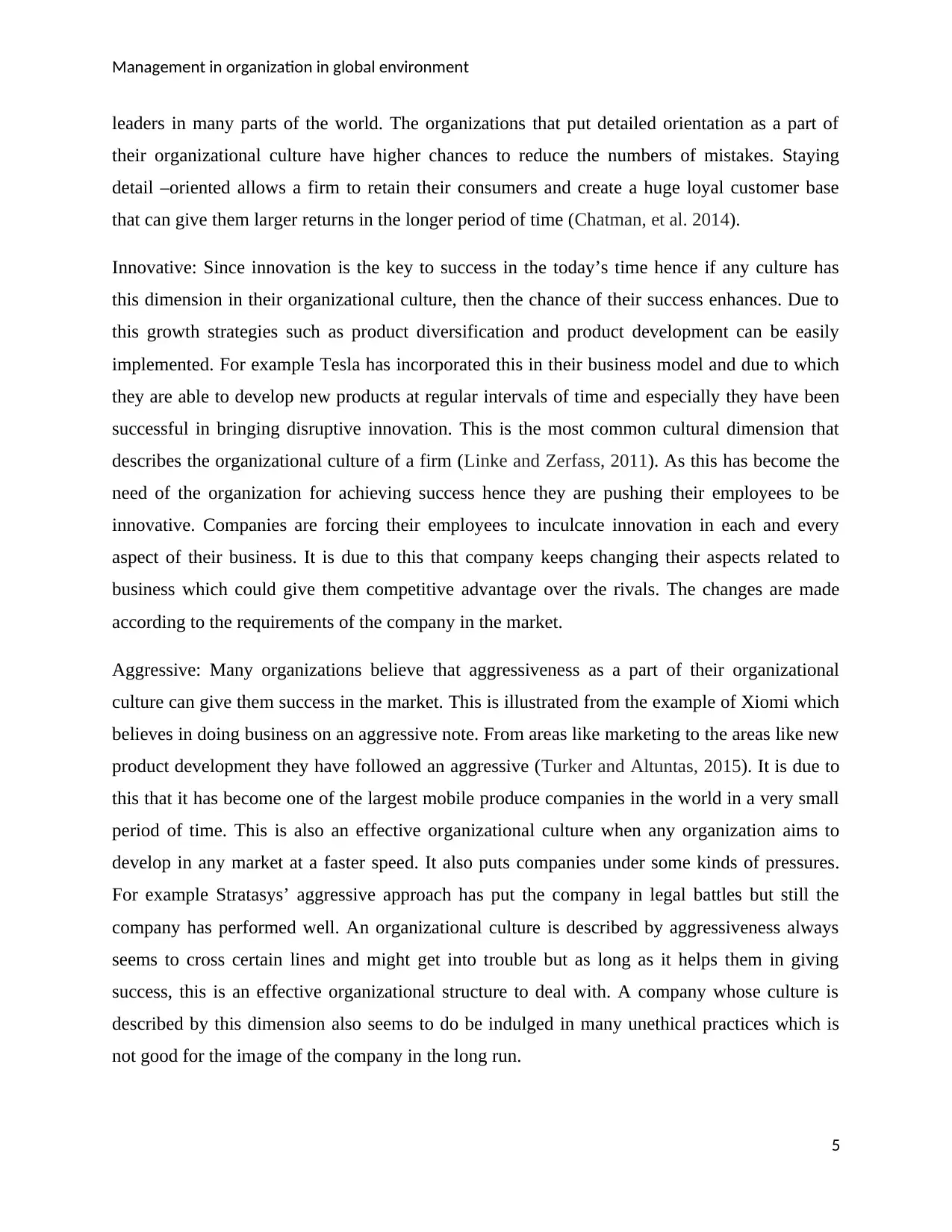
Management in organization in global environment
leaders in many parts of the world. The organizations that put detailed orientation as a part of
their organizational culture have higher chances to reduce the numbers of mistakes. Staying
detail –oriented allows a firm to retain their consumers and create a huge loyal customer base
that can give them larger returns in the longer period of time (Chatman, et al. 2014).
Innovative: Since innovation is the key to success in the today’s time hence if any culture has
this dimension in their organizational culture, then the chance of their success enhances. Due to
this growth strategies such as product diversification and product development can be easily
implemented. For example Tesla has incorporated this in their business model and due to which
they are able to develop new products at regular intervals of time and especially they have been
successful in bringing disruptive innovation. This is the most common cultural dimension that
describes the organizational culture of a firm (Linke and Zerfass, 2011). As this has become the
need of the organization for achieving success hence they are pushing their employees to be
innovative. Companies are forcing their employees to inculcate innovation in each and every
aspect of their business. It is due to this that company keeps changing their aspects related to
business which could give them competitive advantage over the rivals. The changes are made
according to the requirements of the company in the market.
Aggressive: Many organizations believe that aggressiveness as a part of their organizational
culture can give them success in the market. This is illustrated from the example of Xiomi which
believes in doing business on an aggressive note. From areas like marketing to the areas like new
product development they have followed an aggressive (Turker and Altuntas, 2015). It is due to
this that it has become one of the largest mobile produce companies in the world in a very small
period of time. This is also an effective organizational culture when any organization aims to
develop in any market at a faster speed. It also puts companies under some kinds of pressures.
For example Stratasys’ aggressive approach has put the company in legal battles but still the
company has performed well. An organizational culture is described by aggressiveness always
seems to cross certain lines and might get into trouble but as long as it helps them in giving
success, this is an effective organizational structure to deal with. A company whose culture is
described by this dimension also seems to do be indulged in many unethical practices which is
not good for the image of the company in the long run.
5
leaders in many parts of the world. The organizations that put detailed orientation as a part of
their organizational culture have higher chances to reduce the numbers of mistakes. Staying
detail –oriented allows a firm to retain their consumers and create a huge loyal customer base
that can give them larger returns in the longer period of time (Chatman, et al. 2014).
Innovative: Since innovation is the key to success in the today’s time hence if any culture has
this dimension in their organizational culture, then the chance of their success enhances. Due to
this growth strategies such as product diversification and product development can be easily
implemented. For example Tesla has incorporated this in their business model and due to which
they are able to develop new products at regular intervals of time and especially they have been
successful in bringing disruptive innovation. This is the most common cultural dimension that
describes the organizational culture of a firm (Linke and Zerfass, 2011). As this has become the
need of the organization for achieving success hence they are pushing their employees to be
innovative. Companies are forcing their employees to inculcate innovation in each and every
aspect of their business. It is due to this that company keeps changing their aspects related to
business which could give them competitive advantage over the rivals. The changes are made
according to the requirements of the company in the market.
Aggressive: Many organizations believe that aggressiveness as a part of their organizational
culture can give them success in the market. This is illustrated from the example of Xiomi which
believes in doing business on an aggressive note. From areas like marketing to the areas like new
product development they have followed an aggressive (Turker and Altuntas, 2015). It is due to
this that it has become one of the largest mobile produce companies in the world in a very small
period of time. This is also an effective organizational culture when any organization aims to
develop in any market at a faster speed. It also puts companies under some kinds of pressures.
For example Stratasys’ aggressive approach has put the company in legal battles but still the
company has performed well. An organizational culture is described by aggressiveness always
seems to cross certain lines and might get into trouble but as long as it helps them in giving
success, this is an effective organizational structure to deal with. A company whose culture is
described by this dimension also seems to do be indulged in many unethical practices which is
not good for the image of the company in the long run.
5
⊘ This is a preview!⊘
Do you want full access?
Subscribe today to unlock all pages.

Trusted by 1+ million students worldwide
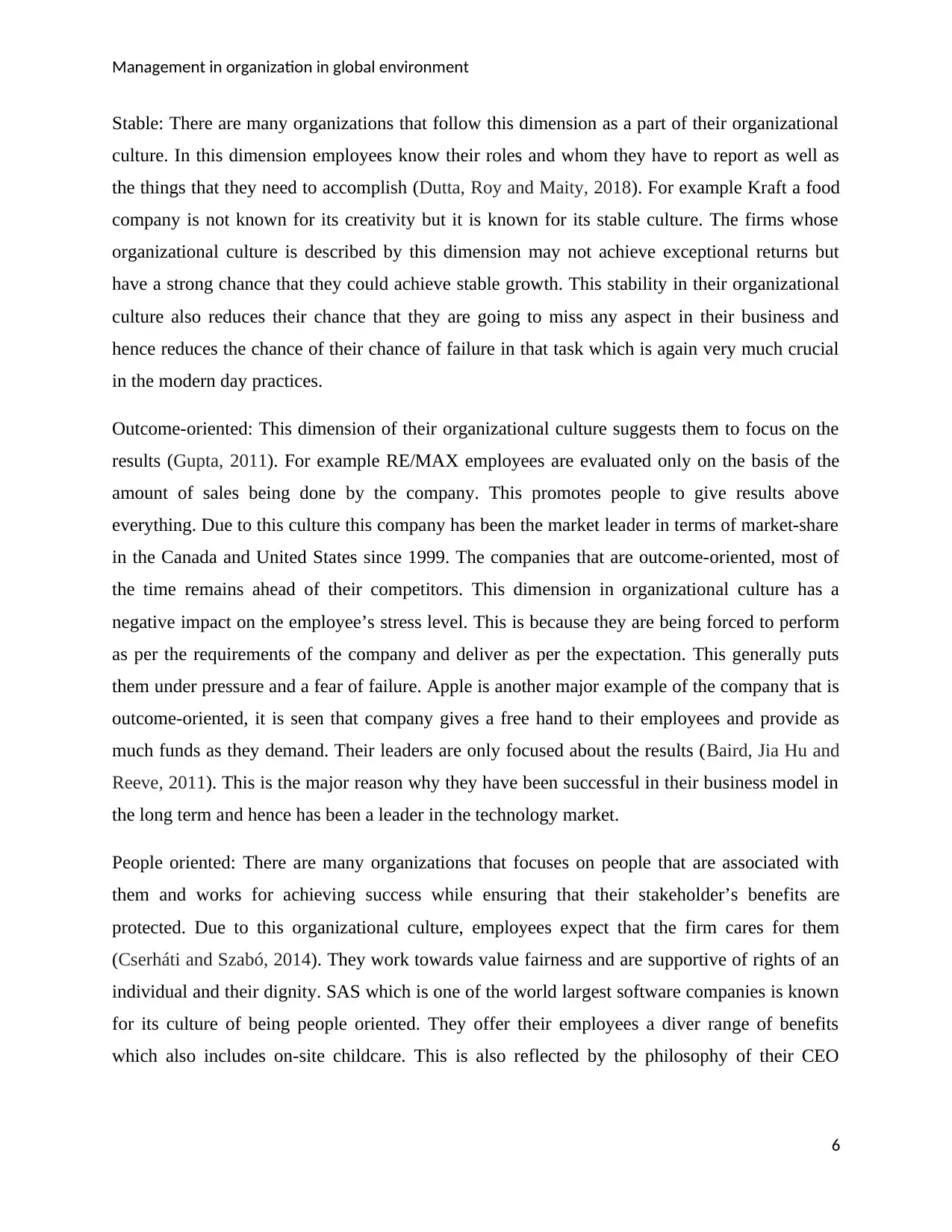
Management in organization in global environment
Stable: There are many organizations that follow this dimension as a part of their organizational
culture. In this dimension employees know their roles and whom they have to report as well as
the things that they need to accomplish (Dutta, Roy and Maity, 2018). For example Kraft a food
company is not known for its creativity but it is known for its stable culture. The firms whose
organizational culture is described by this dimension may not achieve exceptional returns but
have a strong chance that they could achieve stable growth. This stability in their organizational
culture also reduces their chance that they are going to miss any aspect in their business and
hence reduces the chance of their chance of failure in that task which is again very much crucial
in the modern day practices.
Outcome-oriented: This dimension of their organizational culture suggests them to focus on the
results (Gupta, 2011). For example RE/MAX employees are evaluated only on the basis of the
amount of sales being done by the company. This promotes people to give results above
everything. Due to this culture this company has been the market leader in terms of market-share
in the Canada and United States since 1999. The companies that are outcome-oriented, most of
the time remains ahead of their competitors. This dimension in organizational culture has a
negative impact on the employee’s stress level. This is because they are being forced to perform
as per the requirements of the company and deliver as per the expectation. This generally puts
them under pressure and a fear of failure. Apple is another major example of the company that is
outcome-oriented, it is seen that company gives a free hand to their employees and provide as
much funds as they demand. Their leaders are only focused about the results (Baird, Jia Hu and
Reeve, 2011). This is the major reason why they have been successful in their business model in
the long term and hence has been a leader in the technology market.
People oriented: There are many organizations that focuses on people that are associated with
them and works for achieving success while ensuring that their stakeholder’s benefits are
protected. Due to this organizational culture, employees expect that the firm cares for them
(Cserháti and Szabó, 2014). They work towards value fairness and are supportive of rights of an
individual and their dignity. SAS which is one of the world largest software companies is known
for its culture of being people oriented. They offer their employees a diver range of benefits
which also includes on-site childcare. This is also reflected by the philosophy of their CEO
6
Stable: There are many organizations that follow this dimension as a part of their organizational
culture. In this dimension employees know their roles and whom they have to report as well as
the things that they need to accomplish (Dutta, Roy and Maity, 2018). For example Kraft a food
company is not known for its creativity but it is known for its stable culture. The firms whose
organizational culture is described by this dimension may not achieve exceptional returns but
have a strong chance that they could achieve stable growth. This stability in their organizational
culture also reduces their chance that they are going to miss any aspect in their business and
hence reduces the chance of their chance of failure in that task which is again very much crucial
in the modern day practices.
Outcome-oriented: This dimension of their organizational culture suggests them to focus on the
results (Gupta, 2011). For example RE/MAX employees are evaluated only on the basis of the
amount of sales being done by the company. This promotes people to give results above
everything. Due to this culture this company has been the market leader in terms of market-share
in the Canada and United States since 1999. The companies that are outcome-oriented, most of
the time remains ahead of their competitors. This dimension in organizational culture has a
negative impact on the employee’s stress level. This is because they are being forced to perform
as per the requirements of the company and deliver as per the expectation. This generally puts
them under pressure and a fear of failure. Apple is another major example of the company that is
outcome-oriented, it is seen that company gives a free hand to their employees and provide as
much funds as they demand. Their leaders are only focused about the results (Baird, Jia Hu and
Reeve, 2011). This is the major reason why they have been successful in their business model in
the long term and hence has been a leader in the technology market.
People oriented: There are many organizations that focuses on people that are associated with
them and works for achieving success while ensuring that their stakeholder’s benefits are
protected. Due to this organizational culture, employees expect that the firm cares for them
(Cserháti and Szabó, 2014). They work towards value fairness and are supportive of rights of an
individual and their dignity. SAS which is one of the world largest software companies is known
for its culture of being people oriented. They offer their employees a diver range of benefits
which also includes on-site childcare. This is also reflected by the philosophy of their CEO
6
Paraphrase This Document
Need a fresh take? Get an instant paraphrase of this document with our AI Paraphraser
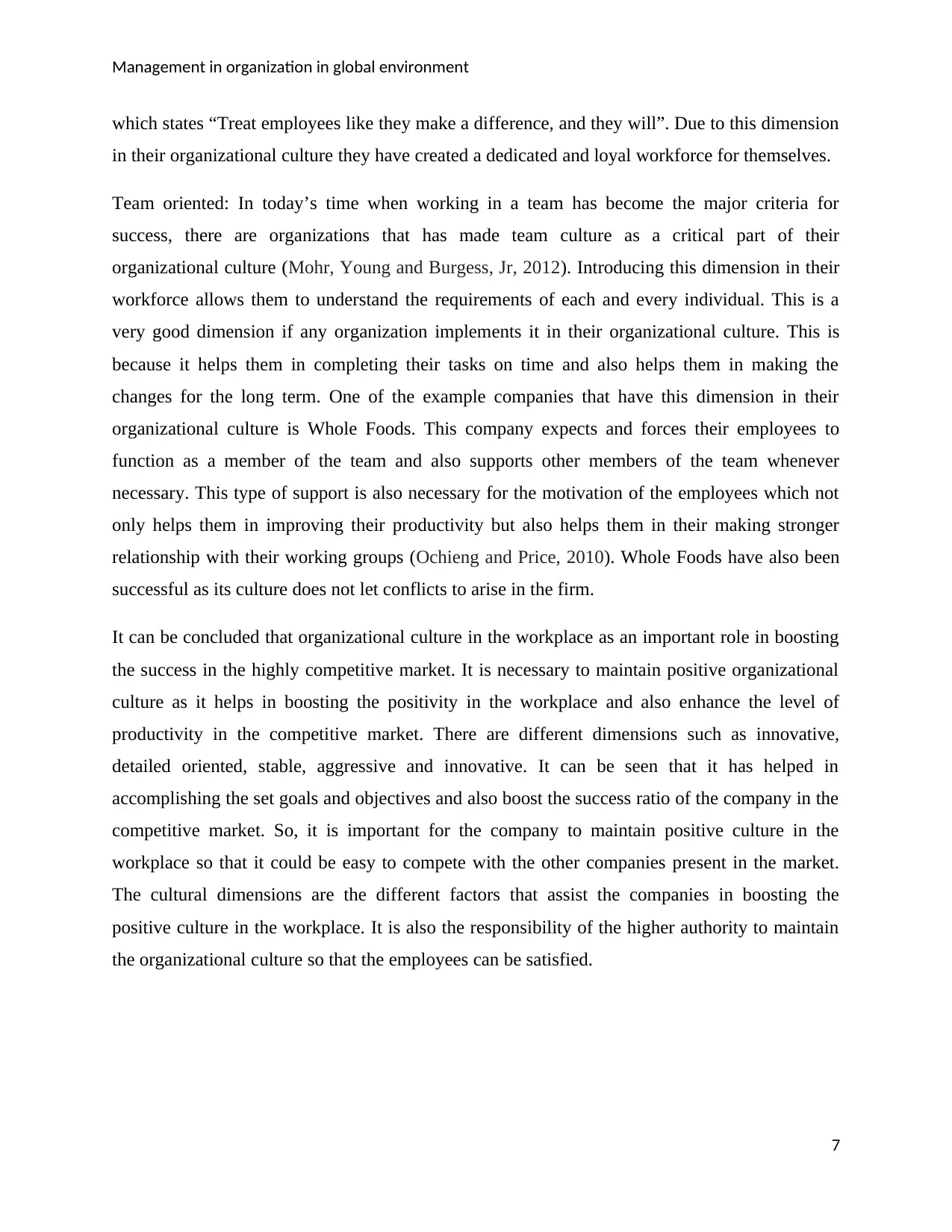
Management in organization in global environment
which states “Treat employees like they make a difference, and they will”. Due to this dimension
in their organizational culture they have created a dedicated and loyal workforce for themselves.
Team oriented: In today’s time when working in a team has become the major criteria for
success, there are organizations that has made team culture as a critical part of their
organizational culture (Mohr, Young and Burgess, Jr, 2012). Introducing this dimension in their
workforce allows them to understand the requirements of each and every individual. This is a
very good dimension if any organization implements it in their organizational culture. This is
because it helps them in completing their tasks on time and also helps them in making the
changes for the long term. One of the example companies that have this dimension in their
organizational culture is Whole Foods. This company expects and forces their employees to
function as a member of the team and also supports other members of the team whenever
necessary. This type of support is also necessary for the motivation of the employees which not
only helps them in improving their productivity but also helps them in their making stronger
relationship with their working groups (Ochieng and Price, 2010). Whole Foods have also been
successful as its culture does not let conflicts to arise in the firm.
It can be concluded that organizational culture in the workplace as an important role in boosting
the success in the highly competitive market. It is necessary to maintain positive organizational
culture as it helps in boosting the positivity in the workplace and also enhance the level of
productivity in the competitive market. There are different dimensions such as innovative,
detailed oriented, stable, aggressive and innovative. It can be seen that it has helped in
accomplishing the set goals and objectives and also boost the success ratio of the company in the
competitive market. So, it is important for the company to maintain positive culture in the
workplace so that it could be easy to compete with the other companies present in the market.
The cultural dimensions are the different factors that assist the companies in boosting the
positive culture in the workplace. It is also the responsibility of the higher authority to maintain
the organizational culture so that the employees can be satisfied.
7
which states “Treat employees like they make a difference, and they will”. Due to this dimension
in their organizational culture they have created a dedicated and loyal workforce for themselves.
Team oriented: In today’s time when working in a team has become the major criteria for
success, there are organizations that has made team culture as a critical part of their
organizational culture (Mohr, Young and Burgess, Jr, 2012). Introducing this dimension in their
workforce allows them to understand the requirements of each and every individual. This is a
very good dimension if any organization implements it in their organizational culture. This is
because it helps them in completing their tasks on time and also helps them in making the
changes for the long term. One of the example companies that have this dimension in their
organizational culture is Whole Foods. This company expects and forces their employees to
function as a member of the team and also supports other members of the team whenever
necessary. This type of support is also necessary for the motivation of the employees which not
only helps them in improving their productivity but also helps them in their making stronger
relationship with their working groups (Ochieng and Price, 2010). Whole Foods have also been
successful as its culture does not let conflicts to arise in the firm.
It can be concluded that organizational culture in the workplace as an important role in boosting
the success in the highly competitive market. It is necessary to maintain positive organizational
culture as it helps in boosting the positivity in the workplace and also enhance the level of
productivity in the competitive market. There are different dimensions such as innovative,
detailed oriented, stable, aggressive and innovative. It can be seen that it has helped in
accomplishing the set goals and objectives and also boost the success ratio of the company in the
competitive market. So, it is important for the company to maintain positive culture in the
workplace so that it could be easy to compete with the other companies present in the market.
The cultural dimensions are the different factors that assist the companies in boosting the
positive culture in the workplace. It is also the responsibility of the higher authority to maintain
the organizational culture so that the employees can be satisfied.
7
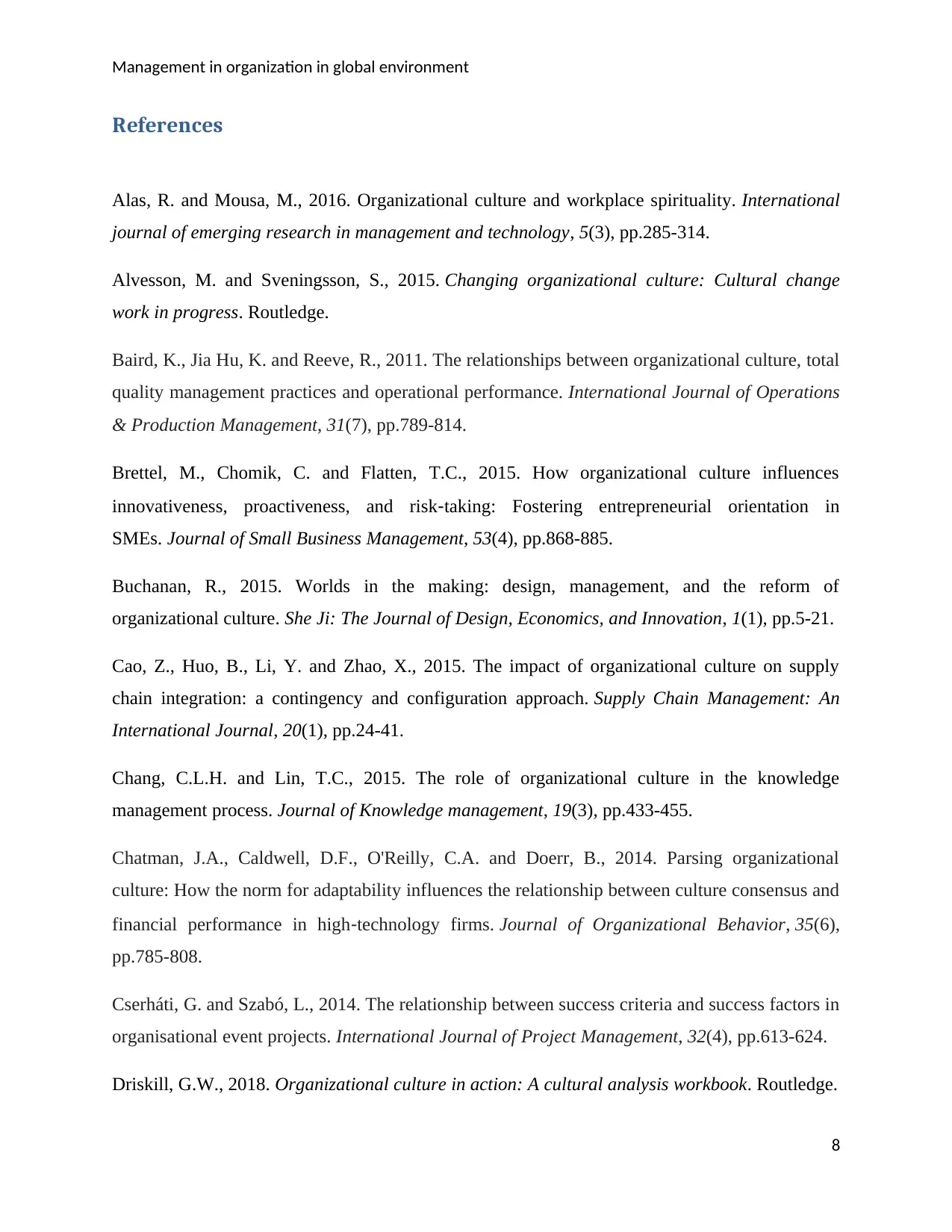
Management in organization in global environment
References
Alas, R. and Mousa, M., 2016. Organizational culture and workplace spirituality. International
journal of emerging research in management and technology, 5(3), pp.285-314.
Alvesson, M. and Sveningsson, S., 2015. Changing organizational culture: Cultural change
work in progress. Routledge.
Baird, K., Jia Hu, K. and Reeve, R., 2011. The relationships between organizational culture, total
quality management practices and operational performance. International Journal of Operations
& Production Management, 31(7), pp.789-814.
Brettel, M., Chomik, C. and Flatten, T.C., 2015. How organizational culture influences
innovativeness, proactiveness, and risk‐taking: Fostering entrepreneurial orientation in
SMEs. Journal of Small Business Management, 53(4), pp.868-885.
Buchanan, R., 2015. Worlds in the making: design, management, and the reform of
organizational culture. She Ji: The Journal of Design, Economics, and Innovation, 1(1), pp.5-21.
Cao, Z., Huo, B., Li, Y. and Zhao, X., 2015. The impact of organizational culture on supply
chain integration: a contingency and configuration approach. Supply Chain Management: An
International Journal, 20(1), pp.24-41.
Chang, C.L.H. and Lin, T.C., 2015. The role of organizational culture in the knowledge
management process. Journal of Knowledge management, 19(3), pp.433-455.
Chatman, J.A., Caldwell, D.F., O'Reilly, C.A. and Doerr, B., 2014. Parsing organizational
culture: How the norm for adaptability influences the relationship between culture consensus and
financial performance in high‐technology firms. Journal of Organizational Behavior, 35(6),
pp.785-808.
Cserháti, G. and Szabó, L., 2014. The relationship between success criteria and success factors in
organisational event projects. International Journal of Project Management, 32(4), pp.613-624.
Driskill, G.W., 2018. Organizational culture in action: A cultural analysis workbook. Routledge.
8
References
Alas, R. and Mousa, M., 2016. Organizational culture and workplace spirituality. International
journal of emerging research in management and technology, 5(3), pp.285-314.
Alvesson, M. and Sveningsson, S., 2015. Changing organizational culture: Cultural change
work in progress. Routledge.
Baird, K., Jia Hu, K. and Reeve, R., 2011. The relationships between organizational culture, total
quality management practices and operational performance. International Journal of Operations
& Production Management, 31(7), pp.789-814.
Brettel, M., Chomik, C. and Flatten, T.C., 2015. How organizational culture influences
innovativeness, proactiveness, and risk‐taking: Fostering entrepreneurial orientation in
SMEs. Journal of Small Business Management, 53(4), pp.868-885.
Buchanan, R., 2015. Worlds in the making: design, management, and the reform of
organizational culture. She Ji: The Journal of Design, Economics, and Innovation, 1(1), pp.5-21.
Cao, Z., Huo, B., Li, Y. and Zhao, X., 2015. The impact of organizational culture on supply
chain integration: a contingency and configuration approach. Supply Chain Management: An
International Journal, 20(1), pp.24-41.
Chang, C.L.H. and Lin, T.C., 2015. The role of organizational culture in the knowledge
management process. Journal of Knowledge management, 19(3), pp.433-455.
Chatman, J.A., Caldwell, D.F., O'Reilly, C.A. and Doerr, B., 2014. Parsing organizational
culture: How the norm for adaptability influences the relationship between culture consensus and
financial performance in high‐technology firms. Journal of Organizational Behavior, 35(6),
pp.785-808.
Cserháti, G. and Szabó, L., 2014. The relationship between success criteria and success factors in
organisational event projects. International Journal of Project Management, 32(4), pp.613-624.
Driskill, G.W., 2018. Organizational culture in action: A cultural analysis workbook. Routledge.
8
⊘ This is a preview!⊘
Do you want full access?
Subscribe today to unlock all pages.

Trusted by 1+ million students worldwide
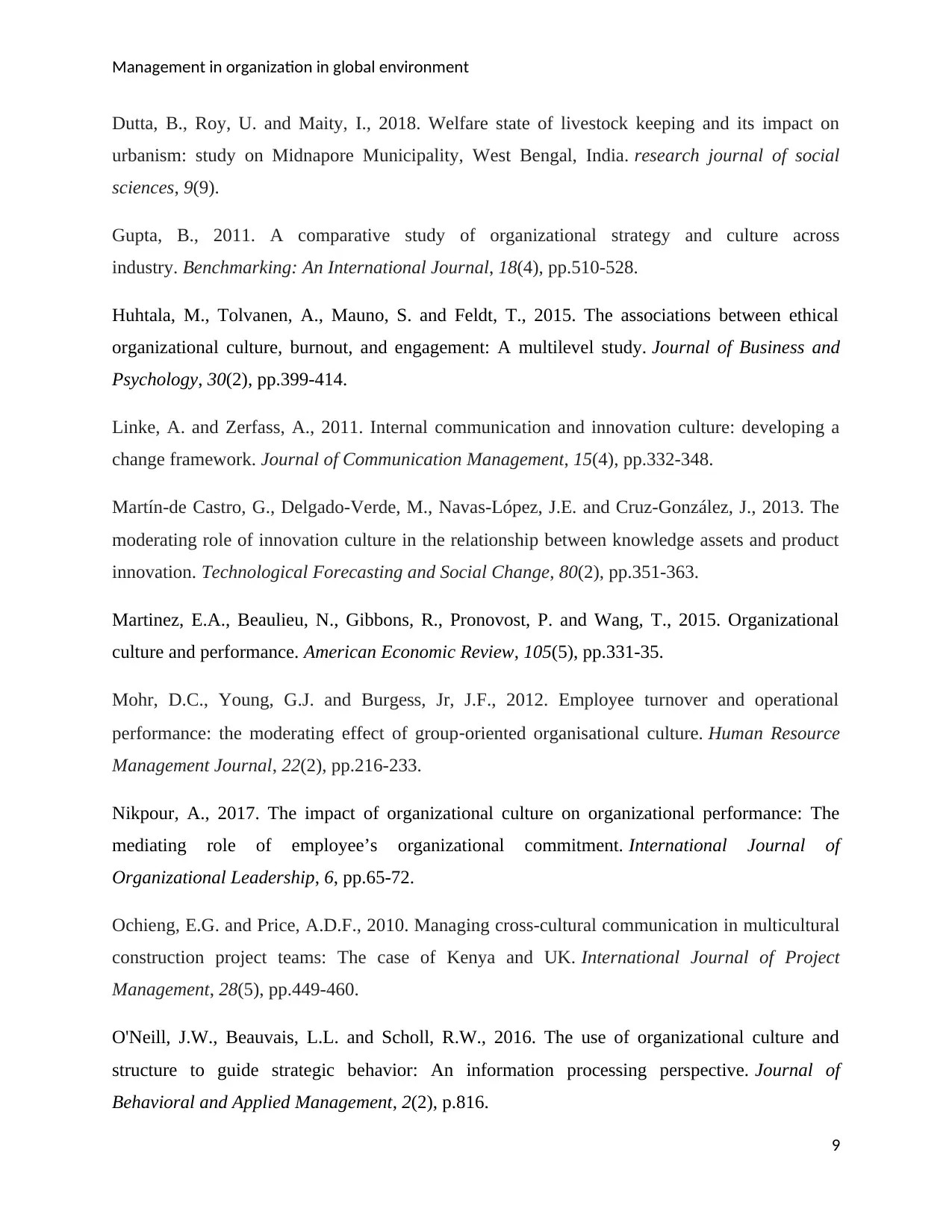
Management in organization in global environment
Dutta, B., Roy, U. and Maity, I., 2018. Welfare state of livestock keeping and its impact on
urbanism: study on Midnapore Municipality, West Bengal, India. research journal of social
sciences, 9(9).
Gupta, B., 2011. A comparative study of organizational strategy and culture across
industry. Benchmarking: An International Journal, 18(4), pp.510-528.
Huhtala, M., Tolvanen, A., Mauno, S. and Feldt, T., 2015. The associations between ethical
organizational culture, burnout, and engagement: A multilevel study. Journal of Business and
Psychology, 30(2), pp.399-414.
Linke, A. and Zerfass, A., 2011. Internal communication and innovation culture: developing a
change framework. Journal of Communication Management, 15(4), pp.332-348.
Martín-de Castro, G., Delgado-Verde, M., Navas-López, J.E. and Cruz-González, J., 2013. The
moderating role of innovation culture in the relationship between knowledge assets and product
innovation. Technological Forecasting and Social Change, 80(2), pp.351-363.
Martinez, E.A., Beaulieu, N., Gibbons, R., Pronovost, P. and Wang, T., 2015. Organizational
culture and performance. American Economic Review, 105(5), pp.331-35.
Mohr, D.C., Young, G.J. and Burgess, Jr, J.F., 2012. Employee turnover and operational
performance: the moderating effect of group‐oriented organisational culture. Human Resource
Management Journal, 22(2), pp.216-233.
Nikpour, A., 2017. The impact of organizational culture on organizational performance: The
mediating role of employee’s organizational commitment. International Journal of
Organizational Leadership, 6, pp.65-72.
Ochieng, E.G. and Price, A.D.F., 2010. Managing cross-cultural communication in multicultural
construction project teams: The case of Kenya and UK. International Journal of Project
Management, 28(5), pp.449-460.
O'Neill, J.W., Beauvais, L.L. and Scholl, R.W., 2016. The use of organizational culture and
structure to guide strategic behavior: An information processing perspective. Journal of
Behavioral and Applied Management, 2(2), p.816.
9
Dutta, B., Roy, U. and Maity, I., 2018. Welfare state of livestock keeping and its impact on
urbanism: study on Midnapore Municipality, West Bengal, India. research journal of social
sciences, 9(9).
Gupta, B., 2011. A comparative study of organizational strategy and culture across
industry. Benchmarking: An International Journal, 18(4), pp.510-528.
Huhtala, M., Tolvanen, A., Mauno, S. and Feldt, T., 2015. The associations between ethical
organizational culture, burnout, and engagement: A multilevel study. Journal of Business and
Psychology, 30(2), pp.399-414.
Linke, A. and Zerfass, A., 2011. Internal communication and innovation culture: developing a
change framework. Journal of Communication Management, 15(4), pp.332-348.
Martín-de Castro, G., Delgado-Verde, M., Navas-López, J.E. and Cruz-González, J., 2013. The
moderating role of innovation culture in the relationship between knowledge assets and product
innovation. Technological Forecasting and Social Change, 80(2), pp.351-363.
Martinez, E.A., Beaulieu, N., Gibbons, R., Pronovost, P. and Wang, T., 2015. Organizational
culture and performance. American Economic Review, 105(5), pp.331-35.
Mohr, D.C., Young, G.J. and Burgess, Jr, J.F., 2012. Employee turnover and operational
performance: the moderating effect of group‐oriented organisational culture. Human Resource
Management Journal, 22(2), pp.216-233.
Nikpour, A., 2017. The impact of organizational culture on organizational performance: The
mediating role of employee’s organizational commitment. International Journal of
Organizational Leadership, 6, pp.65-72.
Ochieng, E.G. and Price, A.D.F., 2010. Managing cross-cultural communication in multicultural
construction project teams: The case of Kenya and UK. International Journal of Project
Management, 28(5), pp.449-460.
O'Neill, J.W., Beauvais, L.L. and Scholl, R.W., 2016. The use of organizational culture and
structure to guide strategic behavior: An information processing perspective. Journal of
Behavioral and Applied Management, 2(2), p.816.
9
Paraphrase This Document
Need a fresh take? Get an instant paraphrase of this document with our AI Paraphraser
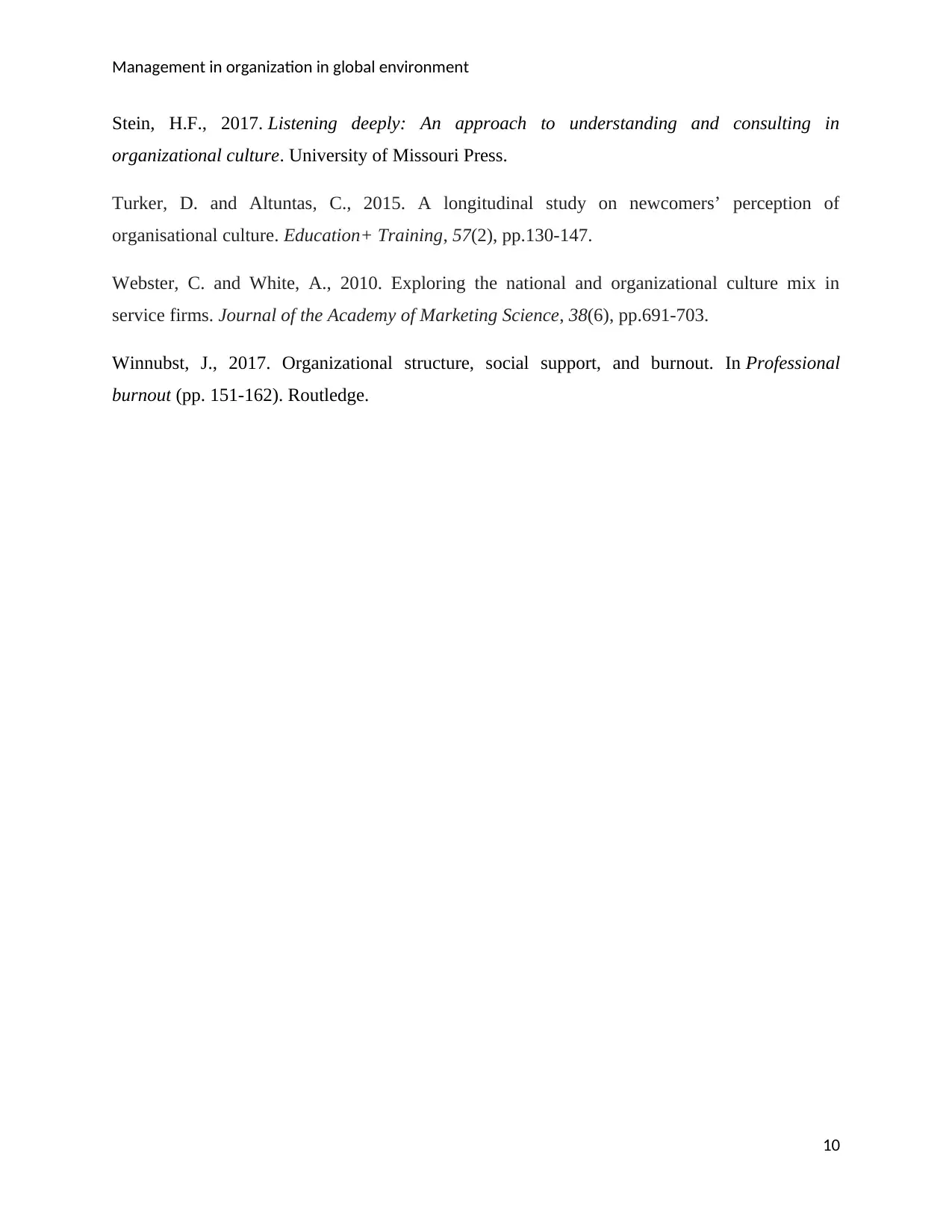
Management in organization in global environment
Stein, H.F., 2017. Listening deeply: An approach to understanding and consulting in
organizational culture. University of Missouri Press.
Turker, D. and Altuntas, C., 2015. A longitudinal study on newcomers’ perception of
organisational culture. Education+ Training, 57(2), pp.130-147.
Webster, C. and White, A., 2010. Exploring the national and organizational culture mix in
service firms. Journal of the Academy of Marketing Science, 38(6), pp.691-703.
Winnubst, J., 2017. Organizational structure, social support, and burnout. In Professional
burnout (pp. 151-162). Routledge.
10
Stein, H.F., 2017. Listening deeply: An approach to understanding and consulting in
organizational culture. University of Missouri Press.
Turker, D. and Altuntas, C., 2015. A longitudinal study on newcomers’ perception of
organisational culture. Education+ Training, 57(2), pp.130-147.
Webster, C. and White, A., 2010. Exploring the national and organizational culture mix in
service firms. Journal of the Academy of Marketing Science, 38(6), pp.691-703.
Winnubst, J., 2017. Organizational structure, social support, and burnout. In Professional
burnout (pp. 151-162). Routledge.
10
1 out of 11
Related Documents
Your All-in-One AI-Powered Toolkit for Academic Success.
+13062052269
info@desklib.com
Available 24*7 on WhatsApp / Email
![[object Object]](/_next/static/media/star-bottom.7253800d.svg)
Unlock your academic potential
Copyright © 2020–2025 A2Z Services. All Rights Reserved. Developed and managed by ZUCOL.





